Lesson 10. Introduction to Encoding
Lesson Files
None
Media
Media > Tiger folder
Time
This lesson takes approximately 60 minutes to complete.
Goals
Learn the definition and use of bit budgeting
Learn about various encoding parameters
Import files into Compressor
Encode files with Compressor
Set up a batch encode
Create a droplet
Understand the difference between PCM and AC-3 audio
Now that you have gone through the various steps of authoring and building a simple DVD, it’s time to kick it up a notch. In the next four lessons, you will build a DVD that contains a movie and a slideshow, just like the Swiss Tourism DVD. Your new project—which is a promotional tool for a documentary on tigers—will introduce some of the more advanced features of DVD authoring. You’ll learn how to build stories using markers, how to set up navigation using scripting, and how to use movies to transition in and out of menus. The Tiger_DVD project will also show you how to use multicolor overlays and multilayer graphic documents or video as background assets.
For a complex project like Tiger that has many assets, it is better to acquire and encode your assets before you begin to author. This lesson will show you how to encode DVD-Video using Compressor. Bundled with both DVD Studio Pro and Final Cut Pro, Compressor offers many more options than DVD Studio Pro’s built-in encoder, without sacrificing ease of use. With Compressor, you can quickly encode one file or batches of QuickTime files into MPEG-2 for your DVD project, using presets or adjusting the compression settings to achieve optimal results.
At the very start of the encoding process, you need to do a little math. In order to accommodate all of the assets you intend to fit on one disc, we need to make sure that their aggregate size will not exceed the disc’s capacity. You will create this “budget” of digital assets first.
Bit Budgeting
Bit budgeting is a system of calculating the final size of a disc based on the elements that are included in the project. It is important to be aware of your project’s final size, since you can fit only a certain amount of information on a disc. This is especially relevant for encoding purposes, due to the large amount of space that video occupies on a DVD. In fact, the majority of your disc is taken up by large MPEG-2 video files, which (despite their extreme compression ratio) can fill up a disc very quickly.
It is often helpful to use bit budgeting equations or special calculators to estimate the size of a DVD project. These formulas can assist you in choosing a bit rate for your video, so that it fits easily on a disc. For example, if you have video that is 2 hours long, a very high bit rate, such as 8 Mbps (megabits per second), might make the resulting MPEG-2 file too large for a 4.7 GB DVD-5 disc, after other assets (audio, subtitles, slideshows, and so on) are factored into the equation.
Compressor empowers you to control the file size of your final project. There is a little bit of math involved, but don’t worry, you will learn a few tricks that make it very easy to calculate the estimated disc size. But take bit budgeting very seriously. Even experienced authors are sometimes forced to re-encode asset files if they don’t properly budget their projects, especially when encoding feature-length materials. In encoding time alone, the process will cost you a lot of time. These mistakes are common ones, and they’re easily avoided if you take the time to bit budget your project before you begin to encode your assets.
A Bit About Bits
Bit budgeting gets its name from the smallest unit of measurement in the digital world: a bit. A bit has a value of either 1 or 0, and these two digits make up the only two numbers in the binary system we refer to as digital. Bits are small, so small they’re usually measured in units of a thousand (kilo), a million (mega), a billion (giga), or a trillion (tera). Chances are, you’ve heard of these prefixes before, followed by the word byte, as in kilobyte, megabyte, gigabyte, and terabyte. A byte is really just a packet of 8 bits, and both bits and bytes are units of measurement, like grams (kilograms). Bits are usually used to measure speed (56 kilobit per second modem), whereas bytes are usually used to measure size (120 gigabyte hard drive). When abbreviated, measurements of bits use lowercase letters, and measurements of bytes use uppercase letters, as in kbps (kilobits per second) versus MB (megabytes).
Bit rate, then, is a measurement of how many bits per second are moving through a phone line, Ethernet cable, or, for our purposes, a DVD player. The more bits there are per second of video, the more bits there are to carry color and luminance information, and the better the image quality.
The goal of bit budgeting is to encode your video and audio assets at the highest possible quality, while keeping the combined file sizes of your assets under the total disc capacity. Figuring out the maximum bit rate with which you can encode your files without making them too large to fit on the DVD is where the “budgeting” part of bit budgeting comes in.
Disc Capacity
The capacity of a disc can be misleading. For example, a DVD-R disc may say it can hold 4.7 GB of data, but the technically accurate amount, which is based on binary number systems, is a little less. Although you might think that 1 MB of information is equivalent to 1,000 kilobytes, it is actually equivalent to 1,024 kilobytes. This means that a 4.7 GB disc actually holds 4.37 GB of information, which is a significant discrepancy when you are working with large projects. A DVD-9 disc, which would seem to hold 8.54 GB of information, actually holds only 7.95 GB.
What If It Doesn’t Fit?
If the assets will not fit on the DVD (as calculated based on a bit rate), you have a number of options:
• Encode your audio to Dolby Digital AC-3 files. This is almost a must for programs longer than 90 minutes. If you encode a 2-hour movie, the available bit rate for the video is a mere 3.4 Mbps. Using Dolby Digital files, you can still encode your video at 4.7 Mbps. How do you save this much room? Because PCM files, although high in quality, are the least efficient file format in the DVD-Video specification. PCM audio files take up 1.5 Mbps of the total bandwidth for playback. However, encoding audio files using Dolby Digital at 192 kbps frees up an additional 1.3 Mbps for your video bit rate.
• Use stories rather than duplicating media. Since stories allow you to perform seamless branching, you can combine several versions of the same program on a disc by reusing media. However, viewers will likely notice a brief pause while the jump occurs.
• Leave assets off the disc. This works only if you are not required to use all elements in your project.
• Author a DVD-9, which will give you a total disc size of 7.95 GB. This will require replication, discussed in Lesson 9.
• Split your project to fit on a second DVD-5 disc.
• Use MPEG-1 compression. This is recommended only if you are not that concerned about the video quality. MPEG-1 will allow you to put almost 8 hours of video on a DVD-5. It is also a valid format for DVD-Video, and you can encode your video using Compressor or any other MPEG-1 encoding tool.
Using the Disc Size Indicator
The DVD Studio Pro toolbar includes an indicator to measure how much space your assets are taking up on a disc.

The problem with using this indicator to monitor progress is that by the time the assets are in your project, they’re already encoded. Unless you want to waste time re-encoding video (and you don’t), calculate the combined file sizes of all your audio and video assets, including motion menu backgrounds, audio for slideshows, and all alternate audio and video streams, before adding them to your project.
Bit Budgeting Methods
An easy bit budgeting method is to calculate a bit rate for your video using the formula 560 ÷ x, where x is the length of your video assets. This formula assumes that you are using compressed audio, such as AC-3. If you are using PCM audio, you need to subtract another 1.3 Mbps from the result of this equation.
For example, if you have 120 minutes of video, you get an approximate bit rate of 4.67 Mbps (560 ÷ 120 = 4.67). If you are using AIFF uncompressed audio that the QuickTime encoder supplies, your available bit rate for your video will be 3.37 Mbps.
Tip
Do not forget that this bit rate is the combined bit rate for audio and video, so you will have to split it between the audio and video streams.
If you are using multiple audio and video streams, you can also use a bit budget calculator, which is usually a simple spreadsheet that helps you calculate the bit rate for your video and audio assets.
Using Storyboards to Bit Budget
Storyboards are useful for bit budgeting, since the storyboard helps you figure out what assets you need. Once you know what assets you need, and their length in minutes, all you have to do is apply the formula to each audio and video asset, and then add them together to see if they will fit on the DVD. If they do not fit, plug a lower bit rate into the formula, recalculate, and try again. Once you’ve determined that all of the assets will fit into your project, you can begin the encoding process with Compressor.
Using Compressor to Encode a File
Compressor can work with files in a variety of ways. When you encoded the Swiss Tourism assets with DVD Studio Pro, you were in effect using Compressor, because DVD Studio Pro’s encoding engine uses the same encoder architecture as Compressor’s. However, DVD Studio Pro lacks some of Compressor’s best features, such as batch encoding and adding professional filters.
By far the most popular and convenient method for using Compressor is to export directly from Final Cut Pro into Compressor. This is especially useful when you have finished editing a project and do not want to compress the file with QuickTime before encoding it with Compressor. You can simply load the sequence you have been editing directly into Compressor without adding steps or compressing it a second time. If you do not want to use extra hard drive space or reduce the quality of your original video, you should export directly into Compressor from Final Cut Pro.
For this lesson, you will be encoding a small video file into MPEG-2 for use on the Tiger_DVD project. Although this file is smaller than a full-length movie, it demonstrates the capabilities of Compressor equally well.
Compression Terminology
This section briefs you on some important compression-related terminology.
Variable Bit Rate vs. Constant Bit Rate
Variable bit rate (VBR) video uses less space on a disc while producing excellent quality, since high bit rates are only allocated to portions of your video that need it the most. For example, a complex scene with lots of motion will get a higher bit rate to handle the extra information, whereas a static scene will use a lower bit rate. In this way, you can save a great deal of space on a disc, which is ordinarily taken up with constant bit rate (CBR) settings on less sophisticated systems.
VBR settings that take two passes—one to analyze a file and the other to encode it—are even better because they save you more space on the disc by using the VBR more accurately due to the initial analysis of the file. The disadvantage of two-pass VBR is that it takes longer to encode.
Average and Maximum Bit Rates
The average bit rate and maximum bit rate settings should match the needs of your project. In general, you want to use the highest quality encoding option your project will allow. For most projects, a setting of 5 or 6 Mbps is best for your average bit rate, which should maintain excellent quality while keeping file sizes manageable. A setting between 7 and 7.5 Mbps is typical for the maximum bit rate.
The maximum bit rate you should use for any video is 8 Mbps, since some DVD players (such as DVD software players on laptop machines) may have difficulty reading data rates that are too fast.
In addition, if you use a high bit rate for your video, you may encounter more problems when building a disc. At times the bit rate will spike, or hit a high point slightly above the maximum value. This causes the disc to be unreadable, and for this reason you should use more conservative bit rate values for your projects.
Finally, there are bit rate limits imposed by the number of camera angles and audio streams used in your project. If you use five angles or fewer, you could encode with 8 Mbps, although it is not recommended. The maximum bit rate for six to eight angles is 7.5 Mbps, and 7 Mbps for nine angles.
GOP—Group of Pictures
Each MPEG stream contains three types of frames that define the video. A group of pictures (GOP) setting defines the pattern of the three frame types used: intra (I) frames, bi-directional (B) frames, and predicted (P) frames. I-frames are also known as reference frames, key frames, or compression frames, and they contain the complete image of the current frame. Markers on a DVD track can be placed only on an I-frame. P-frames are encoded from a “predicted” picture based on the closest preceding I- or P-frame. B-frames are encoded based on interpolation from I- and P-frames.
Lesson 17 explains GOPs in detail. As a general rule, though, you should use a GOP structure with an IBBP pattern, with Closed GOP selected and a GOP size of 15 frames. This is the format that is preferred for most projects, particularly those with multiple angles, which require a closed GOP structure for smoothly switching between track layers. However, if you have to go down to a very low bit rate (such as 3 Mbps), the open GOP structure can help improve the video quality.
For a full review on bit budgeting, including precise calculators and other useful information, please see Appendix B.
Importing a File into Compressor from Final Cut Pro
Use the following steps to see how easy it is to move a video file from Final Cut Pro to Compressor. This is the preferred method of working when your project originates in Final Cut Pro.
Tip
If you don’t have Final Cut Pro or Final Cut Express installed on your computer, you can also import any QuickTime files directly into Compressor. In this case, launch Compressor (Startup disk > Applications > Compressor), choose File > Import, and select the Tiger > Tiger_Assets > Tracks > Tiger_Intro.mov clip. Click Open. Proceed to the next section, “Encoding a Movie.”
1. Launch the Final Cut Pro application by clicking its application icon in the Dock or in the Applications folder on your hard drive.
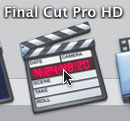
2. Choose File > Import > Files. Navigate to the Tiger_Assets > Tracks folder and select Tiger_Intro.mov. Click Choose.

3. Select the Tiger_Intro.mov clip in the Browser, and drag it to the Timeline.

4. In the Browser, double-click Sequence 1 and name it Tiger_Intro.
5. Choose File > Save Project As to save your project as Tiger_Movie in the My_Projects folder on your hard drive.
6. Select the Tiger_Intro sequence in the Browser, and choose File > Export > Using Compressor.

Once you’ve exported your movie, the Compressor application automatically launches and the Batch window appears. The Batch window is a list of files and their associated encoding settings. You have only one file to encode at the moment—that file is listed in the Batch window’s Source Media column, by the project and sequence name.
This indicates that the file has been successfully exported from Final Cut Pro to Compressor, and it is now ready to be assigned compression settings.
7. Click in the Batch Name field of the Batch window, name your batch Tiger_Encodes1, and press Enter.

Encoding a Movie
Once your movie has been imported into Compressor, you can begin the encoding process. To fit on a DVD, QuickTime media must be converted and compressed using an MPEG-2 encoder such as Compressor.
In typical Apple fashion, Compressor simplifies the encoding process by offering a number of preset compression settings. Compressor’s presets run through the entire spectrum of encoding options, from faster but lower-quality constant bit rate encoding, to slower but vastly superior one-pass and two-pass variable bit rate encoding with motion estimation. These presets allow you to quickly pick encoding settings and get on with authoring your DVD, even if you haven’t the slightest idea what any of the terms in the previous sentence mean.
In this exercise, you will apply a basic preset. Later in this lesson, you will learn how to modify default settings and create your own presets, and you’ll even learn how to create droplets, which will simplify the compression process even more. Ready? Let’s encode.
1. In Compressor’s Batch window, select Media Filename Style, and click to open the Setting pop-up menu.

Tip
If you did not import from Final Cut Pro, your file will be called Tiger_Intro.mov.
2. Choose DVD: Best Quality 90 minutes – 4:3 > All from the list of presets.

Compressor automatically assigns three presets to the file: an AIFF preset, a Dolby Digital AC-3 preset, and an MPEG-2 preset (For more information on AIFF and Dolby Digital files, see the “About Dolby Digital (AC-3) Audio” section). There have been three presets assigned to the file, and two of them are audio presets. Of course, you need only one final audio stream, and it’s up to you to choose between the uncompressed AIFF or the file-size compressed Dolby Digital file. But keep this in mind: In many situations, the file size and data-rate savings of a Dolby Digital file more than make up for the very slight decrease in audio quality that results from compressing the sound. By encoding both an AIFF and a Dolby Digital file in the same batch, you can quickly open and audition both streams after encoding has finished, and then choose the one that most suits your project’s needs.

The higher the bit rate, the better the quality your encoded video will have, and if you look at the MPEG-2 preset, you can see that this video stream will be encoded at 6.4 Mbps (it’s ok if your preset is 6.2). However, along with this higher quality setting comes a larger file size. Usually, to fit 60 minutes or more onto a single disc, the video must be compressed at a lower bit rate in order to take up less space on the disc. Since the disc you are building has less than 60 minutes of video, you can safely use a bit rate of 6.4 Mbps, or even higher to encode the video stream.
3. Click to open the Destination pop-up menu for the AIFF 48/16 File.

Source is the default option, which places the encoded files in the same directory as your original media. This is not recommended, especially when exporting directly out of FCP, since it places the encoded files on the root level of your hard drive. From the pop-up menu you can choose Desktop, your Movies folder, and other destination options.
4. From the Destination pop-up menu, choose Other. A menu appears.

5. Select a destination for your encodes files. Click the New Folder button. In the New Folder dialog, name the folder Encodes.

6. Click Create, then click Open in the pop-up menu to link the Encodes folder to its destination. Now you’ve established that the destination of the encoded AIFF file is the Encodes you folder.
7. In the Presets window, click the Destinations tab. (If you can’t see the Presets window, choose Window > Presets, or press Cmd-2.)
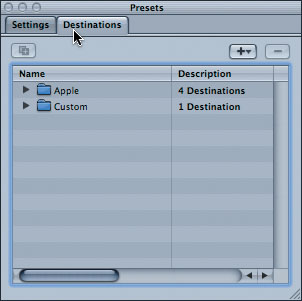
8. Click the plus (+) button and choose Local from the pop-up menu to create a new destination.

9. Select the Media > Encodes folder you just created, and click Open in the pop-up menu that appears.
10. In the Destinations tab, select the new Untitled Local-1 destination.

The Inspector updates to show you information about this destination.
11. In the Inspector, name the preset Encodes and press Return.

12. Choose Compressor > Preferences to open the Preferences window.
13. From the Default Destination menu, chase the Encodes folder.
This sets the Encodes folder as your default destination so every newly encoded file is always sent to a place where you can easily find it (of course, you can override the default destination at any time by simply selecting a new destinations preset).

14. Click Apply to close the Preferences window.
15. In the Batch window, assign the Dolby Digital file and the MPEG-2 file to the Encodes Destination preset.
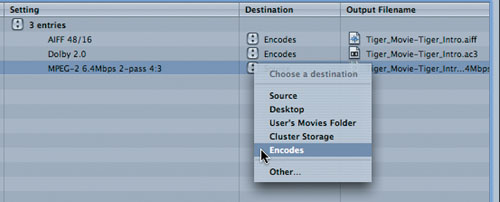
You are now ready to encode this Tiger_Intro movie to MPEG-2. In the next excercise, you will explore what kinds of settings you have chosen for this particular clip.
About Dolby Digital (AC-3) Audio
Properly encoded audio is important for any DVD project, particularly larger projects where the size of your audio files may take up a lot of disc space, not to mention the bandwidth that they must share with video streams. Before creating a DVD, you should decide what type of audio your project requires. The two primary choices are PCM and Dolby Digital (AC-3) audio.
PCM (Pulse Code Modulated) audio is an uncompressed format that takes up a lot more disc space than compressed audio such as AC-3. Its primary file types are AIFF, WAV, and Sound Designer formats. The QuickTime MPEG Encoder (used by QuickTime Pro, Final Cut Pro, and DVD Studio Pro) automatically creates a PCM file when compressing a video file with an audio track attached.
Dolby Digital audio, which is also called AC-3, is a compressed 48 kHz file that maintains excellent quality while significantly reducing the amount of space (and bit rate) on a disc. You might think of the comparison between PCM and AC-3 as similar to audio on a compact disc and an MP3 file. One is significantly larger than the other, although the difference in quality can be negligible. Another advantage of AC-3 is that it can contain up to 5.1 channels of audio in a single file. This makes it possible to deliver true surround sound mixes that come close to re-creating the movie theater experience.
In addition to using different formats for uncompressed audio and surround sound, DVD Studio Pro can utilize multiple audio streams within a track. In fact, with DVD Studio Pro, you can make use of the maximum of eight audio streams allowed by the DVD specification.
Exploring Encoding Settings
Although the presets included with Compressor offer a full range of encoding options, it’s important to see how these presets were made, in case you wish to tweak the settings of a preset and create your own.
1. Choose Window > Presets to open the Presets window, or if it’s already on your screen, simply click it to bring it to the front.

Tip
The four main windows of Compressor can be brought up in the following ways:
• Selecting the window from the Window menu
• Pressing Cmd-1 through Cmd-4
2. In the Presets window, click the Settings tab.

Take a look at one of the Apple Presets to see how encode settings work.
3. Click the disclosure triangle next to the Apple settings group, next to the disclosure triangle the DVD: Best Quality 90 minutes – 4:3.
4. Double-click the MPEG-2 6.4 Mbps 2-Pass 4:3 setting.
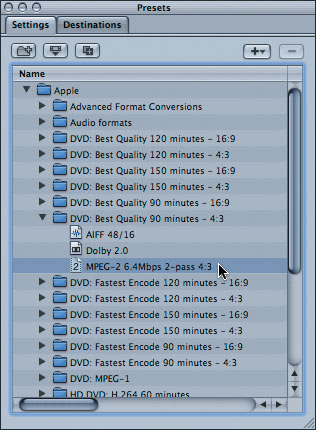
The setting opens in the Inspector, where you can now see a summary of its properties. For example, the Summary pane lists the various attributes of your video and audio, including the original frame rate, frame size, and aspect ratio, as well as the compression settings that will be applied.
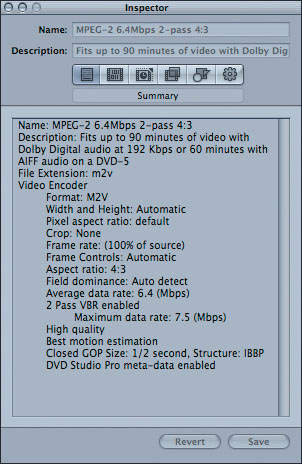
5. Click the Encoder button.

The Encoder pane opens with the Video Format tab selected. A quick glance at this tab shows that the Aspect ratio is 4:3, and the Field dominance is set to Automatic. The Automatic setting usually does a good job of determining the order of your video fields.
6. Click the Quality tab to view the bit rate settings.

In this example, we have chosen the highest quality settings, which create the best possible image quality, but doing so will require the greatest amount of time to encode.
7. Click both the GOP and Extras tabs to see what they contain.
Okay, let’s finally encode this file.
8. In the Batch window, click Submit.
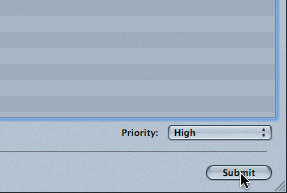
The Batch Monitor launches, which is a separate application from Compressor.
9. Click the disclosure triangles to the left of your batch listings to see the progress of the encoded files.
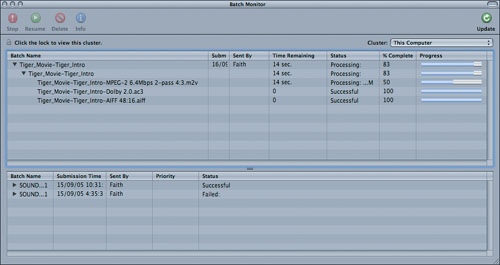
Creating a Preset
In addition to the many presets already available in Compressor, you can create your own presets for encoding video and audio files.
1. Launch Compressor, if it isn’t already open.
2. Open the Presets window by choosing Window > Presets.
3. Choose an encoder setting from the plus (+) menu to create a preset.

The new preset, named Untitled MPEG-2, appears in the Custom settings group.

5. Double-click your new preset in the presets list.
The Inspector opens and/or updates to display the new presets properties.
6. In the Inspector, name your new preset MPEG-2 180min High Quality Encode.

Using the formula 560 ÷ x, or 560 ÷ 180, the max bit rate for 3 hours of video would be 3.1 Mbps.
7. In the Inspector, click the Encoder button. Click the Quality tab, enter 3.1 in the Average Bit Rate Mbps field, and choose “Two pass VBR Best” for the Mode. Leave the Maximum Bit Rate at 7.5.

8. Enter 3.1Mbps,2-Pass VBR, 4:3 in the Description field.


Your custom MPEG-2 preset has been saved, and you can now apply it to video files in Compressor’s Batch window.
Creating a New Preset Group
You can create folders to hold groups of new presets. This allows you to assign multiple presets to a single source media file in the Batch list. You will assign audio and video encoding presets that will create both MPEG-2 video and PCM audio files needed for DVD Studio Pro.
1. In the Presets window, click the Create New Preset Group button.

This creates a new Untitled folder in the Custom settings group.
2. Select the MPEG-2 180min High Quality Encode preset, and move it into the Untitled folder.

3. Click the disclosure triangle next to the Apple settings group and open any DVD preset folder.
4. Select the AIFF 48/16 preset.
5. Click the Duplicate Selected Setting button.

A copy of the AIFF 48/16 setting is created and moved to the bottom of the Custom settings group.
6. Double-click the AIFF 48/16–Copy preset. Use the Inspector’s Name field to remove the “–Copy” text at the end, and press Return. Move it into the Untitled settings group.

7. Select the Untitled settings group.
The Inspector updates to display the untitled settings group’s properties.
8. Click the Inspector’s Name field, and name the settings group MPEG-2, 180min High Quality Encode.

9. Press Return to confirm changes.
You have now created a new preset group for 180-minute encoding.
Creating a Compressor Droplet
The only thing that makes the encoding process simpler than using a preset is applying a Compressor droplet. A droplet is an alias, or shortcut, for launching an application that you can store as an icon on your Desktop or even in your Dock. What makes droplets different is that they not only activate an application, but also perform actions in that application in the background, automatically.
Compressor droplets are useful for quickly and easily encoding several files with the same settings. Dragging a QuickTime file or even a group of files onto a Compressor droplet icon launches Compressor and encodes the files according to the preset it represents. For example, you might decide to create a high-quality MPEG-2 droplet (such as MPEG-2 60min High Quality Encode) for converting a folder of short video clips into MPEG-2 files that can be imported into DVD Studio Pro.
Follow these steps to create a Compressor droplet:
1. In Compressor, open the Presets window by choosing Window > Presets.
2. Select a preset or group of presets you want to save as a droplet from the presets list.
3. In the Settings tab, click the Save Selection as Droplet button.
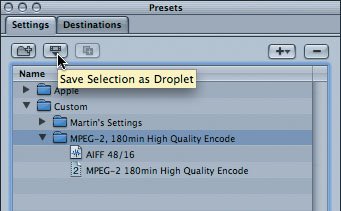
4. From the Where pop-up menu in the Save dialog, choose Desktop as the destination for your droplet.
5. From the “Choose Destination for Droplet results” pop-up menu, choose your Encodes folder.

6. Click Save to create your new droplet.
You will now see a droplet sitting on your Desktop. To use the droplet, simply drop a file onto the droplet icon.

7. Select the Tiger_Transition1.mov and Tiger_Transition2.mov files from the Tiger > Tiger_Assets > Tracks folder, and drag them onto the droplet on the Desktop.
The Droplet window appears with both files listed.

8. Click Submit, and your files will be automatically encoded into your Encodes folder.
Lesson Review
1. What’s the difference between variable bit rate (VBR) and constant bit rate (CBR) encoding?
2. What is the benefit of VBR versus CBR encoding?
3. True or false: You can encode MPEG-2 files using Compressor, directly from a Final Cut Pro Timeline.
4. What’s a droplet?
5. True or false: you can create your own custom Compressor presets.
Answers
1. In VBR files, the data rate can vary over time. In a CBR encode, the data rate stays constant at all times and never varies.
2. VBR encoding provides better picture quality at a lower average data rate because scenes of higher visual complexity (action scenes, fast fades, or pans) can use a higher data rate than scenes with low visual complexity (a tripod mounted shot of a person speaking). In a CBR encode, the data rate never varies. Consequently scenes with high visual complexity suffer in quality, while scenes with low visual complexity have a higher data rate than needed to maintain a good image.
3. True. You can, and you should, because encoding files directly from the Final Cut Pro timeline saves you from rendering out a finished movie, and then encoding.
4. A droplet is a Compressor preset packaged into an icon you can keep on your desktop (or any other folder). To encode a file, just drop it on the droplet.
5. True. While the default presets are great for fast encodes, to configure exactly the type of encode settings you need, you have to create your own preset.

